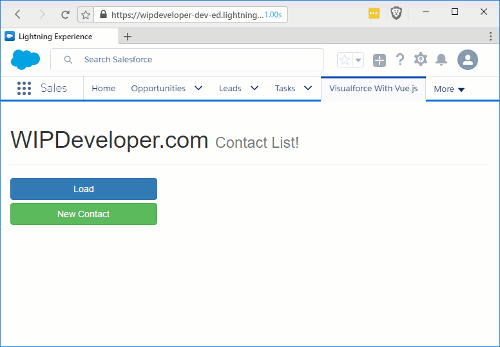Visualforce with Vue.js - Part 6 - RemoteAction Updates, Creates, and Deletes
Brett M. Nelson - Wednesday, April 12, 2017
We've been working on getting our Vue.js app working with @RemoteActions. Last time we took a side trip to get the styles working. Now that things are better let's round out the functionality.
Update Apex
We are going to need to add methods to our Apex class to update, create and delete contacts so let's start by updating our TryVuejsController with 3 new methods: UpdateContact, NewContact, and DeleteContact, you'll never guess what each one is supposed to do...
New TryVuejsController Methods
function updateContact(id, languages) { return new Promise((resolve, reject) => { callRemote('TryVuejsController.UpdateContact', [id, languages], resolve, reject) }) }
function newContact(firstName, lastName, languages) { return new Promise((resolve, reject) => { callRemote('TryVuejsController.NewContact', [firstName, lastName, languages], resolve, reject) }) }
function deleteContact(id) { return new Promise((resolve, reject) => { callRemote('TryVuejsController.DeleteContact', [id], resolve, reject) }) }
Ok maybe you did guess that UpdateContact updates a contact, NewContact creates a new contact, and DeleteContact... well deletes a contact... just like it says on the side of the box.
Update sf.service.js
With our updated contoller we will need to add some calls to the new methods in our JavaScript service. So lets add a updateContact, newContact, and deleteContact. These three methods will call their repsctive counterpart on the server with the required parameters.
New sf.service.js Methods
function updateContact(id, languages) { return new Promise((resolve, reject) => { callRemote('TryVuejsController.UpdateContact', [id, languages], resolve, reject) }) }
function newContact(firstName, lastName, languages) { return new Promise((resolve, reject) => { callRemote('TryVuejsController.NewContact', [firstName, lastName, languages], resolve, reject) }) }
function deleteContact(id) { return new Promise((resolve, reject) => { callRemote('TryVuejsController.DeleteContact', [id], resolve, reject) }) }
Update new-contact.js
Lets start updating the logic that calls our sf.service.js with the new-contact.js. For this we will almost remove everything from the saveContact method and replace it with the following:
Updated new-contact.js saveContact Method
saveContact: function () {
sfService.newContact(this.firstName, this.lastName, this.languages)
.then(() => {
eventHub.$emit('contacts:load')
router.push('/')
})
}
edit-contact.js will be almost the same replacing it's saveContact with the following:
Updated edit-contact.js saveContact Method
saveContact: function () {
sfService.updateContact(this.currentContact.Id, this.currentContact.Languages__c) .then(() => {
eventHub.$emit('contacts:load')
router.push('/')
}) }
Finally let's update the deleteContact method on contact-detail.js with this:
Updated contact-detail.js deleteContact Method
deleteContact: function (id) {
sfService.deleteContact(id) .then(response => {
this.showContact = false
this.currentContact = {}
eventHub.$emit('contacts:load')
})
}
Now you should be able to deploy your resource bundle to your org and see everything working.
The Whole Shabang!

Conclusion
We have reached "feature parity" with our Vue.js and ForceJs app. What should we try next? Let me know by leaving a comment below or emailing [email protected].